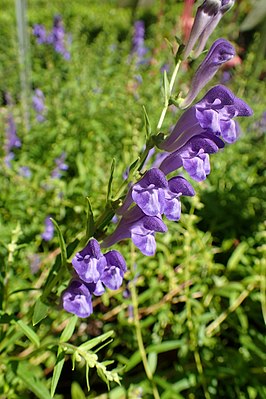Baikal skullcap
| Baikal skullcap | ||||||||||||
|---|---|---|---|---|---|---|---|---|---|---|---|---|

Baikal skullcap ( Scutellaria baicalensis ) |
||||||||||||
| Systematics | ||||||||||||
|
||||||||||||
| Scientific name | ||||||||||||
| Scutellaria baicalensis | ||||||||||||
| Georgi |
The Baikal skullcap ( Scutellaria baicalensis , Chinese huang qin, Japanese Kogane-bana, Korean-hwang geum) is a flowering plant in the family of the mint (Lamiaceae). It is used as a medicinal plant in traditional Chinese medicine.
description
Vegetative characteristics
The Baikal skullcap grows as a perennial herbaceous plant . The ascending to upright shoots reach a stature height of usually 35 to 85, a maximum of 120 centimeters. They arise from a branched, fleshy rhizome about 2 to 3 centimeters in diameter. The rungs arise individually and are richly branched. The opposite leaves are almost sessile (short stalked with a petiole up to 2 millimeters long), the upper sessile. They are entire, lanceolate to linear-lanceolate in outline with a blunt apex, with a length of 1.5 to 4.5 centimeters. Their underside is usually sparsely hairy and also densely covered with sunken glands.
Generative characteristics
The inflorescences form at the ends of the shoots each a dense, one-sided terminal panicle of about 6 to 7 to 10 to 15 centimeters in length. Each flower has a bract , the lower ones resemble the stem leaves, they gradually get smaller towards the tip, the upper ones only 4 to 11 millimeters long. The single flowers are short (about 3 mm long) stalked. The two-lipped, softly hairy calyx reaches about 4 millimeters in length. The "helmet" (scutellum), which gives the genus its name, reaches a height of about 1.5 millimeters at the time of flowering and is enlarged at the time of fruiting. The two-lipped corolla is blue, blue-violet to purple in color, it reaches about 2 to 3 centimeters in length. The lower lip of the flower is three-lobed, with a larger central lobe, and the flower tube is distinctively curved near the base. It is soft-haired on the inside and glandular-haired on the outside.
The Baikal skullcap blooms from July to August.
Chromosome number
The number of chromosomes is 2n = 32.
Occurrence
The Baikal skullcap is found in northern East Asia. It grows in Russia in southeast Siberia, northeast Mongolia, northern Korea. In China, it grows in the northeast, in Gansu , Hebei , Heilongjiang , Henan , Hubei , Jiangsu , Liaoning , Nei Mongol , Shaanxi , Shandong, and Shanxi . It was introduced to Japan and South Korea as a medicinal and ornamental plant in the 18th century.
The species inhabits grasslands, steppes, cultivated land, light oak forests, in China up to 2000 meters above sea level.
ingredients
The Baikal skullcap contains scutellarin , baicalin , wogonoside , oroxylin , essential oils , tannins and resins .
use
The Baikal skullcap is one of the most widely collected medicinal plants for use in traditional Chinese medicine. An aqueous extract ( decoction ) from the roots (and rhizomes) is used. It is used for infectious diseases, rheumatism, arrhythmia, high blood pressure, pneumonia and tuberculosis.
pharmacology
Baikal skullcap is anti- allergenic , anti-inflammatory and antibacterial . Studies have shown that wogonin , an active ingredient in the Baikal skullcap, triggers the “suicide function” ( apoptosis ) in cancer cells , while healthy cells remain completely undisturbed. Research carried out by the Medical University of Vienna in 2011 confirms this. For the ingredient baicalin, progesterone-promoting and anti-abortion effects could be described in animal experiments.
Taxonomy and systematics
The species was first described by the pharmacist, botanist and explorer Johann Gottlieb Georgi in 1775 in his work Comments from a Journey in the Russian Empire in 1772 . Synonyms are Scutellaria lanceolaria Miquel and Scutellaria macrantha Fischer. When the genus was revised in 1990, Alan Paton placed it in the Scutellaria strigillosa species group, section Scutellaria , subgenus Scutellaria . The botanist Arthur Hamilton had previously classified them in a section Galericulata . The classification of Patons is not considered useful for the Chinese flora due to insufficient taxon coverage; in a genetic investigation in 2017, the species group could not be reproduced.
swell
- ↑ a b c d e f Scutellaria baicalensis Georgi . Xi-wen Li & Ian C. Hedge: Family Lamiaceae, in Flora of China online (www.efloras.org), Flora of China, Volume 17 (Lamiaceae, Solanaceae, Verbenaceae).
- ↑ a b c d e f East Asia Biodiversity Conservation Network (editor): Important Plants of East Asia II. Korea National Arboretum, Pocheon, 2015. ISBN 978-89-97450-29-9 .
- ↑ Scutellaria baicalensis at Tropicos.org. In: IPCN Chromosome Reports . Missouri Botanical Garden, St. Louis
- ↑ Isolation and purification of baicalein, wogonin and oroxylin A from the medicinal plant Scutellaria baicalensis by high-speed counter-current chromatography. Hua-Bin Li and Feng Chen, Journal of Chromatography A, 13 May 2005, Volume 1074, Issues 1–2, pages 107–110, https://doi.org/10.1016/j.chroma.2005.03.088
- ↑ Andrew Chevallier: The Great Lexicon of Medicinal Plants. Dorling Kindersley, Starnberg 2001, ISBN 3-8310-0167-7 , p. 134.
- ↑ S. Kohlstädt: Plant ingredient with selective effect on cancer cells. - Press release of the DKFZ from December 12, 2007
- ↑ Der Standard: How the tumor gets into the lymph - derstandard.at .
- ^ AT Ma, XH Zhong, ZM Liu, WY Shi, J. Du, XH Zhai, T. Zhang, LG Meng: Protective effects of baicalin against bromocriptine induced abortion in mice. In: The American journal of Chinese medicine. Volume 37, number 1, 2009, ISSN 0192-415X , pp. 85-95, doi : 10.1142 / S0192415X09006709 , PMID 19222114 .
- ^ Scutellaria baicalensis Georgi , Tropicos, www.tropicos.org. Missouri Botanical Garden. accessed on July 10, 2020.
- ^ Alan Paton (1990): A Global Taxonomic Investigation of Scutellaria (Labiatae). Kew Bulletin 45 (3): 399-450.
- ↑ Sareh Seyedipour, Yasaman Salmaki, Chun-Lei Xiang (2017): Molecular phylogeny of Scutellaria (Lamiaceae; Scutellarioideae) in Iranian highlands inferred from nrITS and trnL-F sequences. Progress in Biological Sciences 7 (2): 169-181 doi: 10.22059 / pbs.2020.270247.1324
